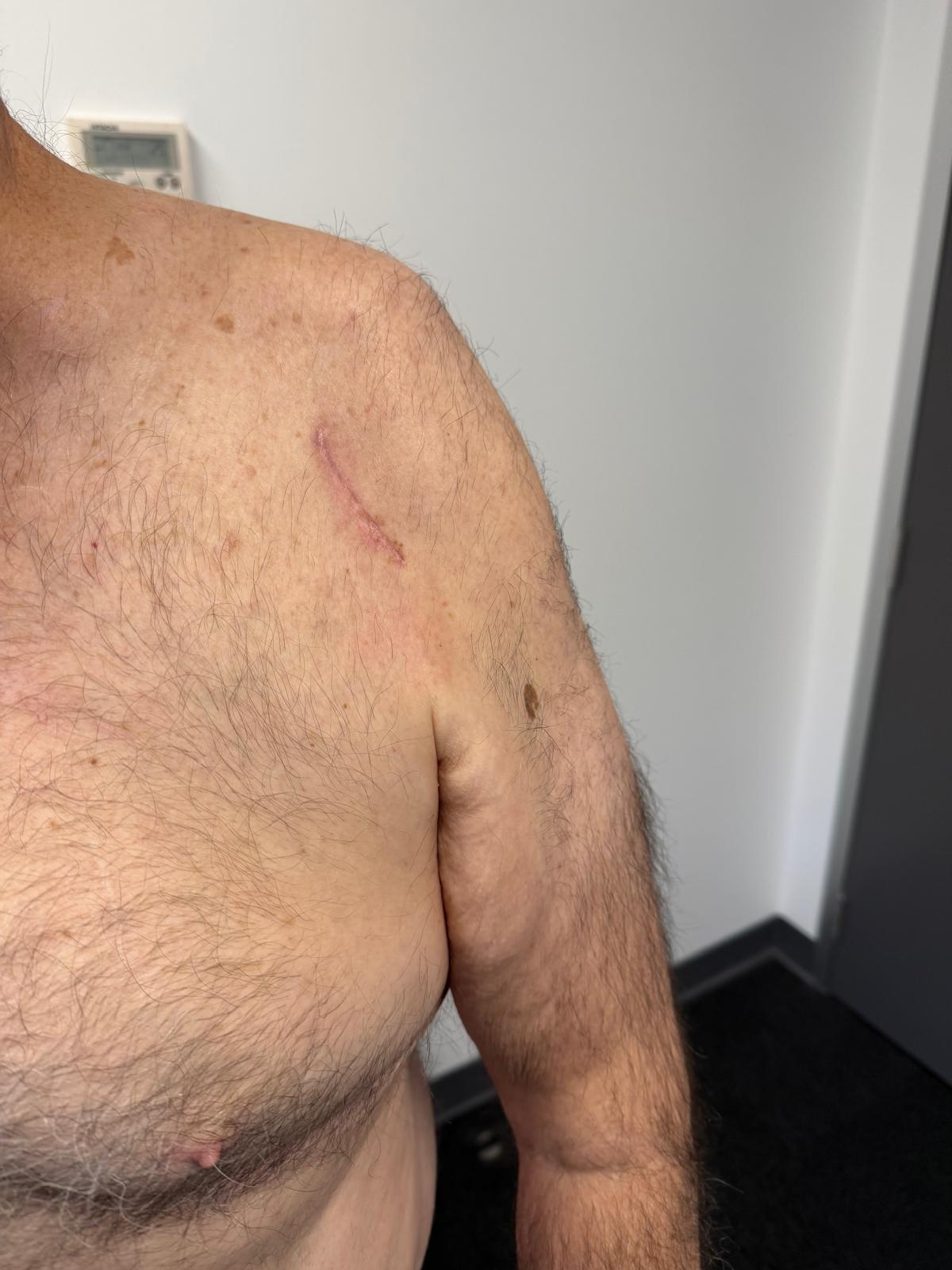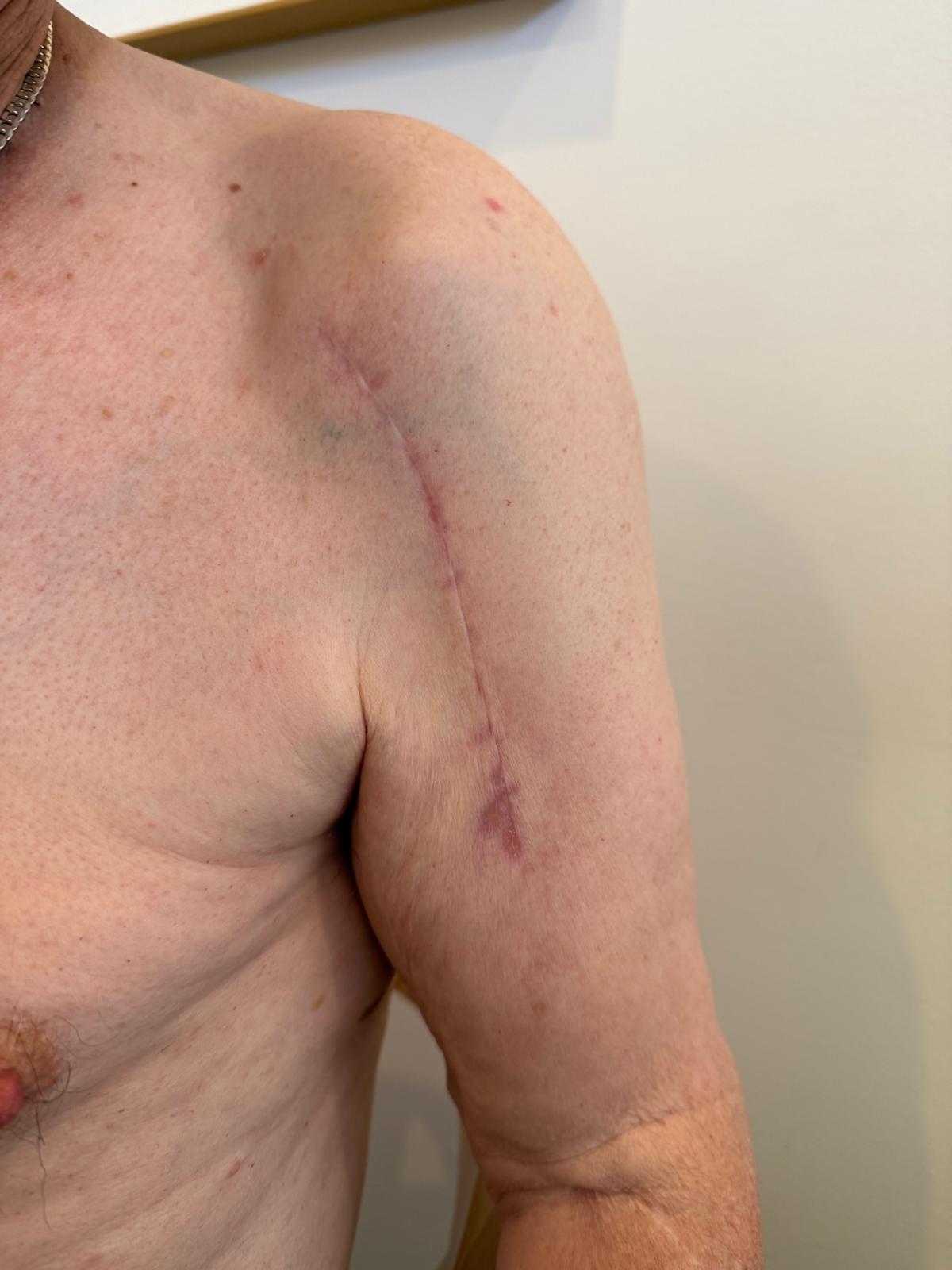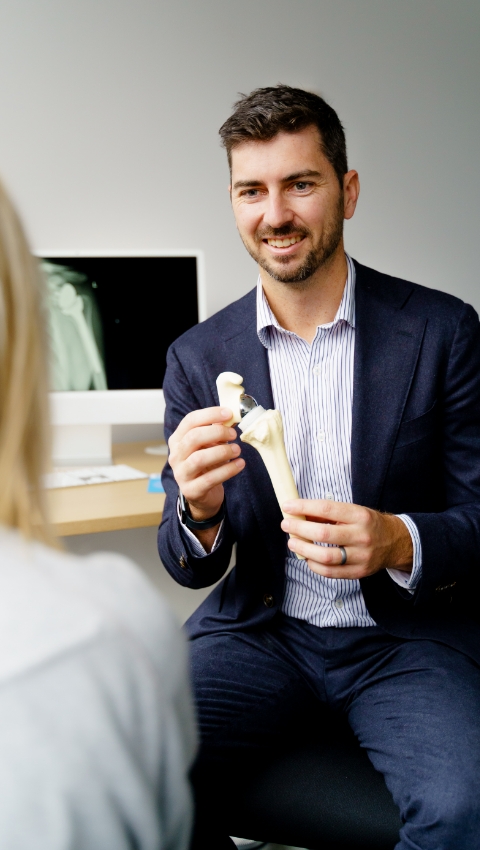Minimally Invasive
Shoulder Joint Replacement
Introducing a Next-Generation Approach: 5cm Mini-Incision Shoulder Replacement
Dr. Oscar Brumby-Rendell of Adelaide Shoulder & Upper Limb Clinic is proud to offer a cutting-edge advancement in shoulder joint replacement surgery: a refined minimally invasive technique using a remarkably small 5cm incision.
Traditional shoulder replacement surgery typically involves larger incisions that can impact surrounding muscle and soft tissue. Dr. Brumby-Rendell has developed a specialised 5cm mini-incision approach that achieves the same surgical goals with significantly less disruption to the surrounding structures.
What does this mean for you?
Less surgical trauma
Faster recovery
Reduced postoperative pain
Smaller, more discreet scar
Improved return to function

Minimally invasive approach

Traditional "open" approach
This exciting development reflects Dr. Brumby-Rendell’s commitment to innovation in upper limb surgery and his focus on outcomes that matter most to patients — function, recovery, and confidence in care.
If you’ve been told you may need shoulder replacement surgery, ask if this advanced mini-incision technique may be right for you.
Who can benefit from a Minimally Invasive
Shoulder Joint Replacement?
Dr Brumby-Rendell endeavours to use his minimally invasive approach for all patients and has successfully done this even in cases with severe deformity that require augmented reconstructions.
After a thorough clinical examination and assessment of each patients specific anatomy he will then be able to decide if minimally invasive is appropriate. Since he started this approach in February 2025 he has been able to do all cases through a minimally invasive approach.
Osteoarthritis is the most common reason for shoulder replacement. Over time, the cartilage that cushions the joint wears down, leading to pain, stiffness, and loss of motion. It most commonly affects people over 60 and can be very debilitating when advanced.
Minimally Invasive Shoulder Joint
Replacement Procedure
With Dr Oscar’s thorough planning, your minimally invasive shoulder joint replacement is customised for your unique needs.
Here’s a detailed look at what this procedure involves and how it aids your recovery.
Diagnosing the Need for a Shoulder Replacement
As an orthopaedic shoulder surgeon, Dr Oscar Brumby-Rendell will diagnose the need for a shoulder replacement through a detailed, patient-centred process that combines clinical expertise, imaging, and personalised planning.
The assessment begins with a comprehensive consultation, where he will take the time to understand your:
-
Shoulder pain symptoms
-
Loss of function
-
Impact on daily activities, sleep, and quality of life
A careful physical examination follows, focusing on your shoulder’s range of motion, strength, and any signs of instability or rotator cuff damage.
To accurately confirm the diagnosis, Dr Oscar routinely uses:
-
X-rays to assess joint space narrowing, bone spurs, and alignment
-
Advanced imaging with MRI to evaluate cartilage wear, bone loss, or rotator cuff tears
-
In all cases, 3D CT planning tools are used to prepare for a customised patient specific shoulder replacement
Dr Brumby-Rendell will typically recommend shoulder joint replacement surgery when:
-
Non-surgical treatments (such as physiotherapy, cortisone injections, or medications) are no longer effective
-
Imaging confirms severe shoulder arthritis, rotator cuff arthropathy, post-traumatic damage, or joint collapse
-
The pain and loss of motion significantly limit your ability to work, exercise, or live independently
Dr Oscar includes the use of patient-specific surgical guides and 3D pre-operative planning, ensuring each shoulder replacement procedure is tailored to your anatomy and lifestyle.
What Happens During Shoulder Replacement Surgery?
As a specialist in minimally invasive shoulder replacement, I perform this procedure using a refined approach designed to reduce tissue trauma and promote faster recovery.
Anaesthesia & Positioning
The procedure is performed in a sterile operating theatre, typically under a general anaesthetic or a combination of general and regional nerve block for improved post-operative pain control.
The patient is positioned upright in a beach chair position, with the arm supported in a specialised surgical arm holder to allow safe and accurate joint exposure.
Minimal Incision Exposure
A 5 cm skin incision is made over the shoulder joint — much smaller than traditional techniques, which often required 10–15 cm. This minimally invasive approach helps reduce soft tissue disruption.
The deltoid and anterior muscles are gently separated just enough to allow access to the underlying joint without cutting muscle attachments unnecessarily.
Humeral Preparation
Once the joint is exposed, the arthritic humeral head (the ball of the shoulder) is carefully dislocated and removed.
Using pre-operative 3D planning, the appropriate implant size is selected to closely match your native anatomy.
A small tunnel is prepared in the upper arm bone (humerus) to accommodate the implant stem. Depending on bone quality, the implant may be:
- Press-fit (uncemented) — allowing natural bone growth into the surface
- Or cemented for immediate fixation in softer bone
Glenoid (Socket) Replacement
If the socket side of the joint (glenoid) also needs replacing, which is common in both anatomic and reverse shoulder replacements, it is carefully prepared by:
- Sizing and aligning the implant
- Drilling anchor holes for fixation
Placing a specialised glenoid component secured with locking screws with pre-determined trajectories based on preoperative planning or by using intraoperative CT-guided navigation.
Implant Assembly & Closure
The final stage involves assembling the humeral head component onto the implanted stem.
After checking fit and stability, the joint is re-aligned and the soft tissues are carefully reconstructed.
The skin is closed using deep absorbable sutures, and a single biologically inert monofilament for skin to minimise the skin irritation of the wound to reduce the chances of infection/inflammation.
A post-operative X-ray is taken while you are still in theatre to confirm accurate placement of the prosthesis.
In need of a consultation? Dr Oscar offers you a robust guidance and personalized treatment options to help you get back to doing what you love, pain-free.
Recovery and Rehabilitation
Immediate Post-operative Care:
Post-surgery, your arm will be supported in a sling (2-4 weeks). We'll provide pain medication and antibiotics for comfort and infection prevention.
Early physiotherapy is vital. Starting soon after surgery, it restores shoulder mobility and strength. Your commitment to prescribed home exercises directly impacts your results.
Post Surgery Instructions:
-
Prioritise rest – strictly avoid lifting/pushing/pulling initially.
-
Diligently complete home exercises (your physio will guide you).
-
Protect your shoulder – overuse now risks permanent stiffness.
-
Hold off driving for several weeks.
-
Keep incisions dry until healed – showers only with waterproof dressings.

"I couldn't believe how small the incision was!”
(patient 6 weeks post minimally invasive shoulder replacement with Dr Brumby-Rendell)
Frequently Asked Questions
While both implant types generally use similar prosthetic materials, longevity depends more on the quality of the implant, surgical precision, patient activity level, and bone health. In properly selected patients and with good surgical technique, minimally invasive implants can last as long as those placed via traditional approached; often 15-20 years or more. Ongoing follow-ups and avoiding excessive stress help prolong lifespan.
Why Choose Dr Oscar Brumby-Rendell?
Dr Oscar has undergone rigorous training both locally and internationally, including a distinguished fellowship with the International Bone Research Association and specialised microsurgical training. He emphasises personalised care, ensuring that each patient receives tailored treatment designed to meet their unique needs and preferences. Dr Oscar is dedicated to achieving the best possible surgical outcomes for his patients.
Ready to learn more?
Watch more shoulder related videos with Dr Oscar Brumby-Rendell.
Read more articles about shoulder-injury operation Dr Brumby-Rendell performs here:

